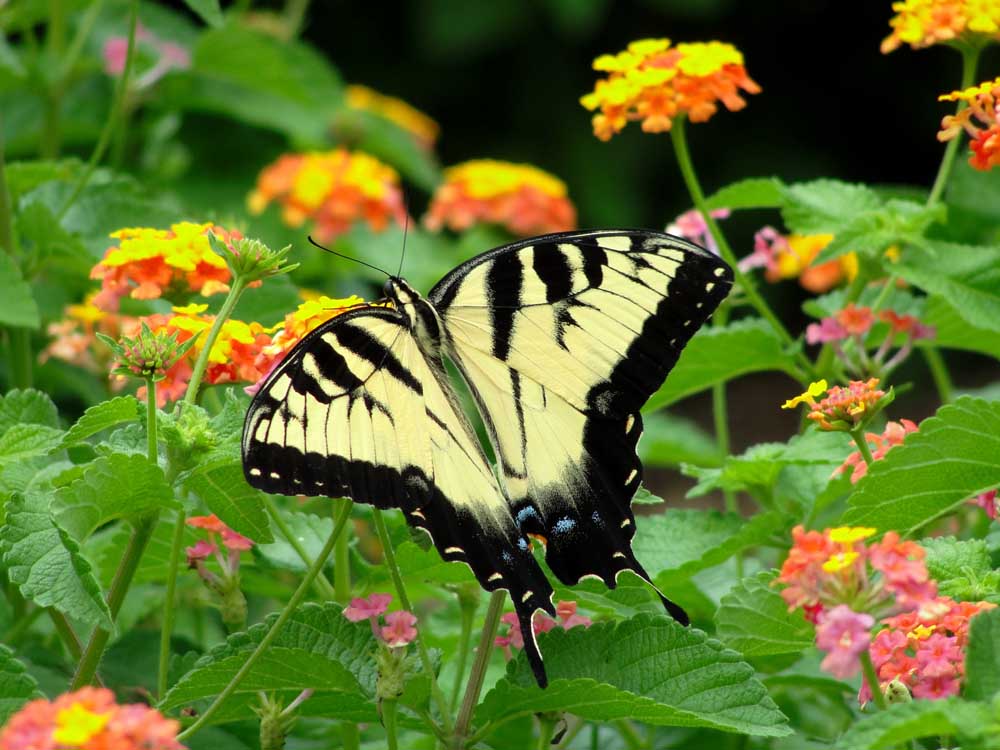Tiger swallowtails can usually be spotted until the first November frost
Published 8:00 am Wednesday, July 25, 2018

- An eastern swallowtail butterfly sips nectar from a colorful lantana. (Courtesy)
The swallowtail butterfly family contains up to 700 species in the world, most of them tropical. More than two dozen are found in North America with seven found regularly in Texas. Swallowtail butterflies earned their name due to their long tails, reminiscent of the birds known as swallows.
One of the most distinct (and one of my favorite) swallowtail butterflies is the eastern tiger swallowtail. Its vertical yellow and black tiger stripes make it unmatched in the butterfly world. The only one remotely similar is the delicate black and white zebra swallowtail, which is only found in the pineywoods of East Texas where pawpaws are native. The eastern tiger swallowtail, on the other hand, is found as far west as Interstate 35 in Texas. It’s considered the first butterfly in North America to be portrayed in art. John White, Sir Walter Raleigh’s third expedition commander, painted it in 1587 on Roanoke Island.
It’s impossible to distinguish black and yellow striped males from females. However the tiger swallow tail has a blackish female form that mimics the toxic pipevine swallowtail. But when the light shines through the undersides of her dark wings, the even darker black tiger stripes can be seen above the single row of orange spots. One has to be stealthy and up close to observe this distinction but I relish the opportunity to spot the hidden tiger. You can be sure when you see the dark form, that it’s always a female. Regrettably like all swallowtails, tiger swallowtails beat their wings when nectaring, making photography and sometimes identification a bit tricky.
Good places to hunt for tiger swallowtails sipping nectar are on azaleas, buttonbush, lantana, lilacs, narcissus, pentas, phlox, thistles and vitex. They are common in both the wild and in gardens, but like all butterflies can come in waves between absent periods. Tiger swallowtails are generally the first large butterflies I see each spring. I can usually count on them on my Grand Primo narcissus in late February or my lilacs in March. During the summer time they are particularly fond of garden phlox. They can usually be spotted up until our first frost November. Like most butterflies, the adults only live for a few fleeting weeks.
Nectar from flowers is important to butterflies, but host plants for the larvae are just as important. The most common larval host plants for tiger swallowtails are ash trees and black cherry trees, but apparently a number of other woody species will suffice as well. The early young larvae look just like bird droppings, a trick that keeps them safe from hungry birds. Mature larvae are green with large eyespots on their swollen thorax, another scare tactic for the birds.
An excellent butterfly reference book for Texas is “Butterflies of Houston and Southeast Texas” by John and Gloria Tveten (1996, University of Texas Press).
Greg Grant is the Smith County horticulturist for the Texas A&M AgriLife Extension Service. You can read his “Greg’s Ramblings” blog at arborgate.com or read his “In Greg’s Garden” in each issue of Texas Gardener magazine (texasgardener.com). More science-based gardening information from the Texas A&M AgriLife Extension Service can be found at aggie-horticulture.tamu.edu.






